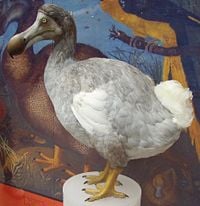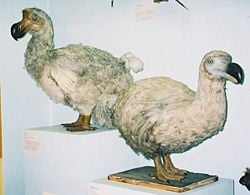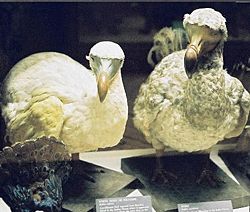Difference between revisions of "Dodo" - New World Encyclopedia
Alisa Opar (talk | contribs) m |
Alisa Opar (talk | contribs) (→References: added source) |
||
| Line 24: | Line 24: | ||
[[Image:Dodo 1.JPG|thumb|200px|left|Dodo reconstruction at [[Oxford University Museum of Natural History]]]] | [[Image:Dodo 1.JPG|thumb|200px|left|Dodo reconstruction at [[Oxford University Museum of Natural History]]]] | ||
| − | In October 2005, Dutch and Mauritian researchers found 2,000-year-old bones of about 20 Dodos in Mauritius. These findings were made public in December 2005 by Naturalis, the Netherlands scientific institute in Leiden. Before this find, few Dodo specimens were known, and no complete skeleton has ever been found. | + | In October 2005, Dutch and Mauritian researchers found 2,000-year-old bones of about 20 Dodos in Mauritius. These findings were made public in December 2005 by Naturalis, the Netherlands scientific institute in Leiden. Before this find, few Dodo specimens were known, and no complete skeleton has ever been found. Today, no complete specimens are preserved, although a number of museum collections contain Dodo skeletons. A Dodo egg is on display at the East London museum in South Africa. Analysis of genetic material recovered from TK proved that the Dodo was a member of the pigeon family and its closest living relative is the '''Nicobar pigeon''' (''Caloenas nicobarica'') from the Nicobar Islands and nearby Southeast Asia (Shapiro 2002). |
| − | + | <[[Dublin]]'s [[Natural History Museum (Ireland)|Natural History Museum]] had an assembled specimen, while the most intact remains from a single bird are a skeletal foot and a head, which contains the only known soft tissue remains of the species. The decaying remnants of the last complete stuffed Dodo, in [[Oxford]]'s [[Ashmolean Museum]], was ordered burned by the museum's director in 1755; the foot and head were salvaged from this specimen, and are currently on display.> | |
| − | The traditional image of the Dodo is of a fat, clumsy bird, but | + | Nevertheless, artists' renditions show the Dodo had blue-grey [[plumage]], a 23-centimetre (9-inch) blackish hooked [[Beak|bill]] with a reddish point, stout yellow legs, a tuft of curly [[feather]]s high on its rear end, and stubby [[wing]]s. Dodos were large birds, weighing about 23 kg (50 pounds). |
| + | |||
| + | The short wings were not used for flight, much like penguins' wings. The breastbone was too small to support the large pectoral muscles that would have been required for flight. Scienctists believe that Dodos evolved from a bird capable of flying that landed on Mauritius. Given the island [[ecology]], with no predators and plenty of food, the Dodo's ancestor didn't need to fly, and eventually the flightless Dodo evolved. | ||
| + | |||
| + | The traditional image of the Dodo is of a fat, clumsy bird, but Andrew Kitchener, a biologist at the [[Royal Museum of Scotland]] argues that the birds were actually lithe and athletic and that the 17th century paintings and drawings showed overfed captive specimens (Kitchener 1993). As Mauritius has marked dry and wet seasons, the Dodo probably fattened itself on ripe fruits at the end of the wet season to survive the dry season when food was scarce. With food readily available in captivity, Kitchener proposes that the birds gorged on an unrestricted diet, becoming plump. | ||
==Extinction== | ==Extinction== | ||
| Line 44: | Line 48: | ||
Roberts points out that because the sighting prior to 1662 was in [[1638]] (i.e. 24 years earlier), the Dodo was likely already very rare by the 1660s. However, [[statistics|statistical]] analysis of the hunting records of [[Isaac Joan Lamotius]], carried out by [[Julian Hume]] and coworkers, gives a new estimated extinction date of [[1693]], with a 95% [[confidence interval]] of [[1688]] to [[1715]]. | Roberts points out that because the sighting prior to 1662 was in [[1638]] (i.e. 24 years earlier), the Dodo was likely already very rare by the 1660s. However, [[statistics|statistical]] analysis of the hunting records of [[Isaac Joan Lamotius]], carried out by [[Julian Hume]] and coworkers, gives a new estimated extinction date of [[1693]], with a 95% [[confidence interval]] of [[1688]] to [[1715]]. | ||
| − | The last known Dodo was killed less than 100 years after the species' discovery | + | The last known Dodo was killed less than 100 years after the species' discovery. No one took particular notice of the extinct bird until it was featured in the Caucus race in [[Lewis Carroll]]'s ''[[Alice's Adventures in Wonderland]]'' (1865). With the popularity of the book, the Dodo became a household word: "as dead as a Dodo". The character was named [[Dodo (Alice's Adventures in Wonderland)|Dodo]]. |
| − | |||
| − | No one took particular notice of the extinct bird until it was featured in the Caucus race in [[Lewis Carroll]]'s ''[[Alice's Adventures in Wonderland]]'' (1865). With the popularity of the book, the Dodo became a household word: "as dead as a Dodo". The character was named [[Dodo (Alice's Adventures in Wonderland)|Dodo]]. | ||
==Use as a symbol== | ==Use as a symbol== | ||
| Line 73: | Line 75: | ||
*Beth Shapiro et al (2002): ''Flight of the Dodo'' Science 295: 1683. | *Beth Shapiro et al (2002): ''Flight of the Dodo'' Science 295: 1683. | ||
*Errol Fuller (2002): ''Dodo : from extinction to icon'' | *Errol Fuller (2002): ''Dodo : from extinction to icon'' | ||
| + | *Kitchener, A. 1993. Justice at last for the dodo. ''New Scientist'' 139: 24-7 | ||
*Menting, G., and G. Hard. 2001. ''Vom Dodo lernen - Öko-Mythen um einen Symbolvogel des Naturschutzes'' - In: Naturschutz und Landschaftsplanung H. 1, ISSN 09406808 | *Menting, G., and G. Hard. 2001. ''Vom Dodo lernen - Öko-Mythen um einen Symbolvogel des Naturschutzes'' - In: Naturschutz und Landschaftsplanung H. 1, ISSN 09406808 | ||
*Vincent Ziswiler (1996): ''Der Dodo - Fantasien und Fakten zu einem verschwundenen Vogel'', Zoologisches Museum der Unviversität Zürich, Ausstellungskatalog, ISBN 3952104310 | *Vincent Ziswiler (1996): ''Der Dodo - Fantasien und Fakten zu einem verschwundenen Vogel'', Zoologisches Museum der Unviversität Zürich, Ausstellungskatalog, ISBN 3952104310 | ||
*Quammen, D. 1996. ''The Song of the Dodo: Island Biogeography in an Age of Extinction '' Scribner: New York ISBN 0684827123 | *Quammen, D. 1996. ''The Song of the Dodo: Island Biogeography in an Age of Extinction '' Scribner: New York ISBN 0684827123 | ||
| + | *Shapiro, B, et al. 2002. Flight of the Dodo. ''Science'' 295(5560): 1683 | ||
*Clara Pinto Correia (2003): ''Return of the Crazy Bird : the sad, strange tale of the dodo'' - Copernicus Books. ISBN 0387988769 | *Clara Pinto Correia (2003): ''Return of the Crazy Bird : the sad, strange tale of the dodo'' - Copernicus Books. ISBN 0387988769 | ||
Revision as of 12:39, 31 July 2006
| Dodo Conservation status: Extinct (1681) | ||||||||||||||
|---|---|---|---|---|---|---|---|---|---|---|---|---|---|---|
| 200px | ||||||||||||||
| Scientific classification | ||||||||||||||
| ||||||||||||||
| Binomial name | ||||||||||||||
| Raphus cucullatus (Linnaeus, 1758) |
The Mauritius Dodo (Raphus cucullatus, called Didus ineptus by Linnaeus), more commonly just Dodo, was a meter-high flightless bird of the island of Mauritius, located in the Indian Ocean to the east of Africa. The Dodo, now extinct, was native only to Mauritius and lived on fruit and nested on the ground.
Etymology
The origin of the word "Dodo" is controversial. The name may be related to the Dutch word "dodaars", a water bird known in English as the Little Grebe or Dabchick. Little Grebes are extant, or still living, but they are similar to the Dodo in that they have similar feathers on the hind end and are also clumsy walkers. Whether or not the Dutch named the Dodo after another bird it resembled is uncertain, but the Dutch are known to have called the bird the "walgvogel" ("terrible bird") in reference to the way it tastes (Fryer 2002). Adding to the mystery of where the Dodo's name came from is the fact that "dodo" has been part of the English language since 1628, and the Dutch did not reach Mauritius before 1638. According to The Barnhart Concise Dictionary of Etymology, "dodo" comes from Portuguese doudo (more commonly doido currently) meaning "fool", or, as an adjective, "crazy." The Portuguese word doudo or doido may itself be a loanword from Old English (cp. English "dolt"). Yet another possibility, as author David Quammen noted in his book The Song of the Dodo, is "that 'dodo' was an onomatopoeic approximation of the bird's own call, a two-note pigeony sound like 'doo-doo'."
Description
In October 2005, Dutch and Mauritian researchers found 2,000-year-old bones of about 20 Dodos in Mauritius. These findings were made public in December 2005 by Naturalis, the Netherlands scientific institute in Leiden. Before this find, few Dodo specimens were known, and no complete skeleton has ever been found. Today, no complete specimens are preserved, although a number of museum collections contain Dodo skeletons. A Dodo egg is on display at the East London museum in South Africa. Analysis of genetic material recovered from TK proved that the Dodo was a member of the pigeon family and its closest living relative is the Nicobar pigeon (Caloenas nicobarica) from the Nicobar Islands and nearby Southeast Asia (Shapiro 2002).
<Dublin's Natural History Museum had an assembled specimen, while the most intact remains from a single bird are a skeletal foot and a head, which contains the only known soft tissue remains of the species. The decaying remnants of the last complete stuffed Dodo, in Oxford's Ashmolean Museum, was ordered burned by the museum's director in 1755; the foot and head were salvaged from this specimen, and are currently on display.>
Nevertheless, artists' renditions show the Dodo had blue-grey plumage, a 23-centimetre (9-inch) blackish hooked bill with a reddish point, stout yellow legs, a tuft of curly feathers high on its rear end, and stubby wings. Dodos were large birds, weighing about 23 kg (50 pounds).
The short wings were not used for flight, much like penguins' wings. The breastbone was too small to support the large pectoral muscles that would have been required for flight. Scienctists believe that Dodos evolved from a bird capable of flying that landed on Mauritius. Given the island ecology, with no predators and plenty of food, the Dodo's ancestor didn't need to fly, and eventually the flightless Dodo evolved.
The traditional image of the Dodo is of a fat, clumsy bird, but Andrew Kitchener, a biologist at the Royal Museum of Scotland argues that the birds were actually lithe and athletic and that the 17th century paintings and drawings showed overfed captive specimens (Kitchener 1993). As Mauritius has marked dry and wet seasons, the Dodo probably fattened itself on ripe fruits at the end of the wet season to survive the dry season when food was scarce. With food readily available in captivity, Kitchener proposes that the birds gorged on an unrestricted diet, becoming plump.
Extinction
The source of the dodo's extinction is not certain, but recent evidence suggests that it was nearly wiped out by some natural disaster before humans even arrived on the island, its population reduced so severely that it fell below sustainable levels[1].
As with many animals evolving in isolation from significant predators, Dodo was entirely fearless of people, and this, in combination with its flightlessness, made it easy prey. (The island was first visited by the Portuguese in 1505, but the Dutch were the first permanent settlers on the island.)
However, when humans first arrived on Mauritius, they also brought with them other animals that had not existed on the island before, including sheep, dogs, pigs, rats and monkeys, which plundered the Dodo nests, while humans destroyed the forests where they made their homes.
There is some controversy surrounding the extinction date of the Dodo. David Roberts states that "the extinction of the Dodo is commonly dated to the last confirmed sighting in 1662, reported by shipwrecked mariner Volkert Evertsz", but other sources suggest 1681.
Roberts points out that because the sighting prior to 1662 was in 1638 (i.e. 24 years earlier), the Dodo was likely already very rare by the 1660s. However, statistical analysis of the hunting records of Isaac Joan Lamotius, carried out by Julian Hume and coworkers, gives a new estimated extinction date of 1693, with a 95% confidence interval of 1688 to 1715.
The last known Dodo was killed less than 100 years after the species' discovery. No one took particular notice of the extinct bird until it was featured in the Caucus race in Lewis Carroll's Alice's Adventures in Wonderland (1865). With the popularity of the book, the Dodo became a household word: "as dead as a Dodo". The character was named Dodo.
Use as a symbol
- The Dodo rampant appears on the Coat of arms of Mauritius.
- The Dodo is the symbol of the Brasseries de Bourbon, a popular brewer on Réunion Island.
- The Dodo is the symbol and mascot of the Durrell Wildlife Conservation Trust and the Jersey Zoological Park, founded by Gerald Durrell.
- The Dodo is the name, symbol and mascot of Finnish environmental organization Dodo. [2]
- Dodo is the name of an Australian internet and phone service provider. Its mascot is a blue-feathered, yellow-beaked 'dodo' that could fly.
Dodos in popular culture
The Dodo's significance as one of the best-known extinct animals and its singular appearance has led to its widespread use in literature and popular culture.
See also
- Extinct birds
ReferencesISBN links support NWE through referral fees
- BirdLife International 2004. [3]. 2006 IUCN Red List of Threatened Species., World Conservation Union. Retrieved on 11 May 2006. Database entry includes justification for why this species is listed as extinct
- Fryer 2002: [4]
- Errol Fuller (2003): Dodo: A Brief History - Universe. ISBN 0789308401
- Beth Shapiro et al (2002): Flight of the Dodo Science 295: 1683.
- Errol Fuller (2002): Dodo : from extinction to icon
- Kitchener, A. 1993. Justice at last for the dodo. New Scientist 139: 24-7
- Menting, G., and G. Hard. 2001. Vom Dodo lernen - Öko-Mythen um einen Symbolvogel des Naturschutzes - In: Naturschutz und Landschaftsplanung H. 1, ISSN 09406808
- Vincent Ziswiler (1996): Der Dodo - Fantasien und Fakten zu einem verschwundenen Vogel, Zoologisches Museum der Unviversität Zürich, Ausstellungskatalog, ISBN 3952104310
- Quammen, D. 1996. The Song of the Dodo: Island Biogeography in an Age of Extinction Scribner: New York ISBN 0684827123
- Shapiro, B, et al. 2002. Flight of the Dodo. Science 295(5560): 1683
- Clara Pinto Correia (2003): Return of the Crazy Bird : the sad, strange tale of the dodo - Copernicus Books. ISBN 0387988769
External links
- 2006 Mauritius Dodo Expedition - Expedition Weblog
- Dodo skeleton find in Mauritius
- Dodos at the Oxford University Museum of Natural History
- 2005 discovery on Mauritius
- Scientists find 'mass dodo grave'
- Dodo DNA/Protein sequence at the NCBI
- David Reilly: The Tragedy of the Dodo
- David Reilly: Dodo Frequently Asked Questions (FAQs)
- A collection of dodo related information and pictures.
- The daily diary of most recent research trip to Mauritius to look for dodo remains
Credits
New World Encyclopedia writers and editors rewrote and completed the Wikipedia article in accordance with New World Encyclopedia standards. This article abides by terms of the Creative Commons CC-by-sa 3.0 License (CC-by-sa), which may be used and disseminated with proper attribution. Credit is due under the terms of this license that can reference both the New World Encyclopedia contributors and the selfless volunteer contributors of the Wikimedia Foundation. To cite this article click here for a list of acceptable citing formats.The history of earlier contributions by wikipedians is accessible to researchers here:
The history of this article since it was imported to New World Encyclopedia:
Note: Some restrictions may apply to use of individual images which are separately licensed.


